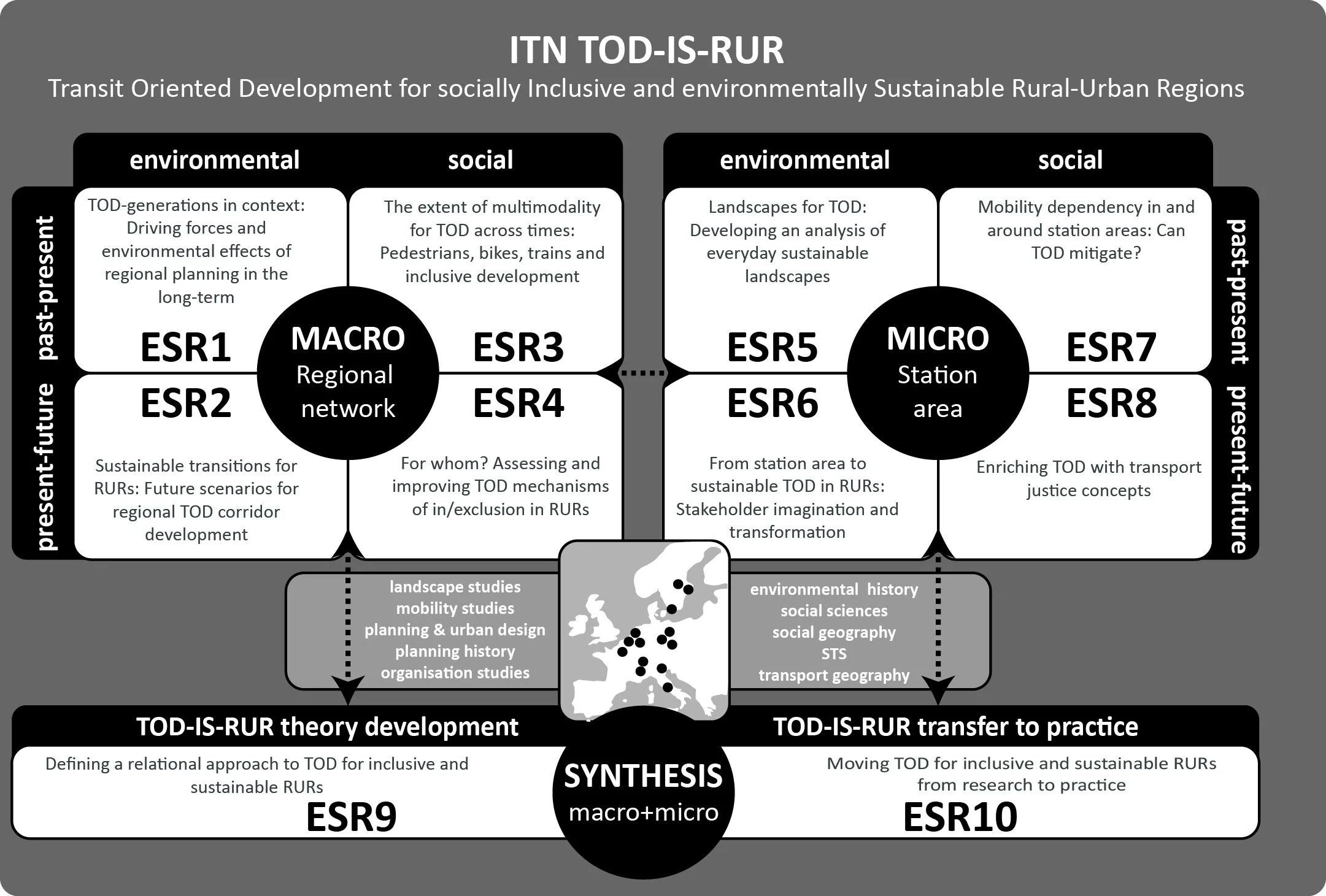
Research program overview
-
Countering sprawl in Europe: Rural-urban placemaking and mobility
Transforming TOD into a sustainable planning concept for rural-urban regions
Mission
Recent reports of the European Environment Agency (EEA), OECD, UN-Habitat, as well as national and regional governments, point to sprawled rural-urban development as one of the greatest challenges to achieve sustainability in Europe and elsewhere. Highlighting mobility-urbanization processes as both the cause and remedy of sprawl, these reports focus on Transit-Oriented Development (TOD) as a promising counterstrategy. Integrating transport and land-use planning, TOD holds the potential to facilitate mobile lives while redirecting car-dependent sprawl to sustainable projects at strategic nodes along the public transit system. Yet, current TOD has an undifferentiated, model-based approach to mobility-urbanization relations as well as an entrenched urban bias in planning; an approach producing strategies that are at odds with differentiated mobility-urbanization relations in rural-urban regions (RURs). As a result of this lack of TOD strategies sensitive to the specificity of rural-urban hybrid landscapes, current TOD is producing environmental unsustainable and social unequal side-effects and risks in RURs.
TOD-IS-RUR will produce an innovative contribution to the scientific and societal challenge of sprawl in Europe. The ITN aims to both accommodate mobility and decentralized living while attracting sustainable and inclusive urbanization around sustainable transport. To meet this aim, TOD-IS-RUR transforms current urban and undifferentiated, model-based approach to TOD into a context-based, interdisciplinary rural-urban approach in which mobility-urbanization relations are analyzed and improved in relation to social and environmental qualities of RURs.
Research
Research and training focus on Transit Oriented Development (TOD) conceiving public transport as a backbone for Inclusive and Sustainable urbanization in European Rural-Urban Regions (TOD-IS-RUR). The overall objective of the Innovative Training Network is to extend TOD to RURs with a context-based approach. If Europe is to make a transition to inclusive and sustainable urbanization, the contextualization and extension of TOD is essential, as most Europeans live in differentiated rural-urban areas, not in undifferentiated urban cores. This ITN will analyze and develop innovative context-based TOD approaches for RURs by bringing in expertise, methods and training from the interdisciplinary domain of urban studies (i.e. mobility studies; landscape research and design; transport justice, planning and geography; social and historical geography; social innovation; Science & Technology Studies (STS); environmental history), and drawing on a wide-range of European rural-urban contexts, thus transcending disciplinary and national fragmentation. Existing and future collaborations among the 9 beneficiary academic partners and 12 partner organizations, create a unique platform for 10 Early Stage Researchers (ESRs), providing innovative, interdisciplinary and intersectoral expert-level training in analyzing and improving TOD for RURs. The research and training will prepare a new generation of highly-skilled professionals able to meet the scientific and societal challenge of countering urban sprawl in the spatial contexts where most Europeans live, developing much-needed approaches for socially inclusive and environmentally sustainable TOD for RURs.
Objectives
To advance a context-based, interdisciplinary approach to TOD for European RURs, the research and training program is structured around three objectives:
Objective 1: At the level of the regional network (ESR1-4) we will challenge the undifferentiated model-based approach of current TOD and will develop context-based approaches able to trace and harness the regional interplay of mobility and urbanization in RURs.
Objective 2: At the level of the local station area (ESR5-8) we will deepen the context-based approach on the local level, studying place-specificity of the station area in rural-urban landscapes and developing context-sensitive approaches to TOD.
Objective 3: At the level of the overall TOD-IS-RUR concept (ESR9-10) we will make use of the research progress of the ESR projects 1 to 8, producing a conceptual approach linking theory, empirics and practice, from which academic and non-academic partners – both governmental and private – can make use to further develop TOD for specific European RURs.
Sharing disciplines, methods, and case-studies, the ESR-research projects will closely collaborate. Objective 1 and 2 are structured by two research axes (past-present/present-future and environmental/social) to increase synergy between the individual ESR-projects. Objective 3 will make use of the research progress of the ESR projects 1-8 and feed back into them with a meta-reflection on theory development and transfer to practice.
Research design

